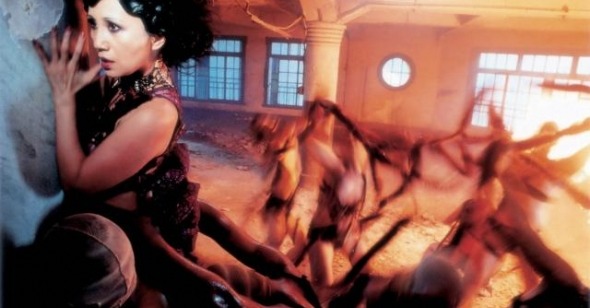The Saddest Music in the World
Michael Koresky on The Wayward Cloud
The Wayward Cloud played April 12, 2015, at Museum of the Moving Image as part of the retrospective Tsai Ming-liang, presented with support from Taipei Cultural Center of TECO in New York.
If one were to see The Wayward Cloud as her or his first Tsai Ming-liang film, one might mistake him for another Asian âExtreme Cinemaâ provocateur. Alongside the still-frame set-ups and studied pacing, thereâs a gross-out extravagance that recalls Takashi Miike, and thereâs even a helping of Jacques Demy thrown in for good measure. But if youâve already seen every other Tsai film, then youâll notice many of the directorâs trademarks; there are elements of The Hole (thereâs a water shortage in Taipei), Vive LâAmour (that filmâs playful game of watermelon bowling here becomes a painful, sloshy bout of watermelon balling), and What Time Is It There? (hints that the two principal characters are the same as those from that earlier masterwork). Yet this film pushes Tsai into heretofore unseen realms of visual flourish and experimentation. The Wayward Cloud feels like Tsaiâs least perfect film . . . and also his boldest.
With Tsaiâs trademark precise, static, yet inexplicably energizing mise-en-scène, The Wayward Cloud unfolds with an otherworldly, almost dreamlike logic. The opening images, of Lee Kang-sheng finger-fucking a halved watermelon compressed between a naked womanâs legs, its juices splashing all over the bed in merciless red puddles, prepare the audience for a queasy trip, and Tsai doesnât disappoint. Tsai has said that he intended to make a film that was very explicitly about pornography, and the porn industry in Taiwan. Lee Kang-sheng, Tsaiâs stoic eternal muse, this time doffs all to display his increasingly beefy physique (seemingly gone is the wiry disaffected teen of Rebels of the Neon God) as porn actor Hsiao-kang, living in the same building as Shiang-chyi Chenâs introverted young woman, named, naturally, Shiang-chyi.
As with the blackout-comedy-sketch setup of Vive LâAmour (which spirals out into ever more profoundly melancholy discontent), the film flirts with a delicate romantic comedy structureâwe secretly hope these lost souls will find each other. Tsai even ups the ante of adorability by homaging, of all things, Annie Hall, when the two deal with a case of runaway crabs that just wonât stay in the boiling pot. This precarious balance of the comic and the calamitous isnât new to Tsai; the darkness to which The Wayward Cloud finally descends only has its equal in the final moments of The River (which devised a way for a father and son to unknowingly engage in consensual steam-room sex). Believe it or not, Tsai goes even further here into the horrors of body invasion, using the world of pornography as a way to explore various types of social exploitation. Never has Tsai seemed so angry, which also may account for the filmâs odd tonal incosistencies, between humor and horror.
Interspersed with the nasty sex, masturbation, and watermelon engorging (water is short yet melons are apparently bountiful) are a series of increasingly absurd lip-synched musical sequences, the first involving Lee Kang-sheng transforming into a melancholy mer-man caterwauling at the moon; the final outfitting Lee with a huge penis hat as he maniacally dances around a grungy bathroom with a bevy of Busby Berkeley-esque pink-bikini-clad girls in inverted scarlet bucket-hats and clutching blue toilet plungers. Obviously, itâs hit or miss, but how can this balls-to-the-wall stuff work any other way? The balance of the gorgeous and the grotesque is well expressed in a sequence after Leeâs character cums on the face of older woman Yi Ching-lu, another Tsai mainstay (ickily, Lee has often played her son in previous Tsai films). Suddenly, we cut to her musical mindscape, a sultry, evocatively lit Kander & Ebb-like Spider Woman number, entrancingly set in a garage; following her is a cobwebbed cadre of male dancers in black unitards, leashed and under her spell. German expressionist, Fosse-fiedâŚwhatever you want to call it, itâs a dazzler and a creative apex for Tsai.
If the method to all this madness seems a little hard to decipher, then the final 20 minutes make for a terrifying crystallization. The mild courting between Lee and Chen finally intersects with the sexual exploitation going on upstairs. Yet Tsaiâs final, truly shocking images are not bolstered by casual moralizing; rather, we realize weâve been watching something larger, the gradual deterioration of a civilization. Itâs in the face of Chen Shiang-chyi that Tsai finds his emotional outlet. In one of the filmâs sole moving shots, the camera creeps ever closer to her horrified face as she watches a particularly nasty porn scenario being enacted against a woman on the other side of a windowed wall. Her witnessing isnât voyeurism as much as it is a gradual coming to terms with her own growing morality. Throughout the film, she had been staving off encroaching social decay, endlessly re-filling bottled water and hoarding melons. In the final scenes, Tsai implies there is no way to reclaim whatâs been lost; her head is nearly impaled on a penis. Nearly dystopic in its portrait of decline, The Wayward Cloud shows Tsai giving up a little control. The newfound lack of restraint suits Tsai well.
